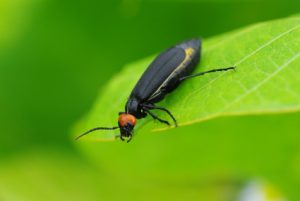What is fun about summer and back yards? Lightning Bugs!

Did you know there are more than 136 species of lightning bugs? And…they all have their own unique flashing lights. A chemical called luciferase, produces this bioluminescence light, so that the lightning bug can attract a mate.
Some people call them fireflies. Entomologists say they are neither a fly or a bug but a winged beetle. An adult is 7/16- to 9/16 inches long with blackish wings and a yellow covering around them.
In late Spring to early Fall as the sun sets, these precious insects take to the air to put on a mesmerizing fire show, captivating children as well as adults. It is the male lightning bug you see flying that produces the flashes to attract a female. The females stay on the ground or on perches near the ground. The males watch for the female’s flash and slowly move closer till at last they find one another.
A female will lay her fertilized eggs a few days after mating, on or just below the ground’s surface. The eggs hatch in about 3 to 4 weeks. As larvae, the insects have three pairs of legs with tiny spots on their underside which glow giving them the name “glowworms”.
But sadly, Lightning bugs are on the decline. Between loss of habitation and light pollution these beneficial insects can’t survive.
Why are they considered beneficial? Well, they don’t bite, they don’t attack, they have no pincers, they don’t carry diseases and they are not poisonous. The larvae of these insects are predators and feed on other insect larvae like slugs and snails.
Also, these charming insects are helping scientists. Remember what makes the light or flash, luciferase, a rare chemical used in research on heart disease, cancer, multiple sclerosis and cystic fibrosis.
To learn more about beneficial insects and how to keep your gardens pest free and pesticide free contact Brad The Bugman today at 800.328.9140 or visit www.marchbiological.com.
